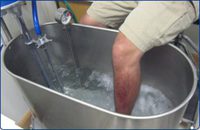 27th Oct 2015
27th Oct 2015
Using Physical Therapy to Treat Osteoarthritis Patients with Total Knee Replacements
There are more than 719,000 knee replacements performed in the United States each year. Osteoarthritis is a degenerative condition that makes patients at a higher risk for the need of a total knee replacement. A new study published in the New England Journal of Medicine concluded patients with Osteoarthritis who received total knee replacements and participated in physical therapy healed better and were able to return to their daily activities faster than those patients who only received knee replacements.
Physical therapy is able to not only improve function, but relieve pain, making the rehabilitation process post knee replacement easier. Physical therapy will address the issues Osteoarthritis patients in need of knee replacements experience with multiple modalities in order to address their broad range of needs.
Whirlpool Therapy is just one of several effective Physical Therapy Modalities
for treating patiients with Osteoarthritis.
Physical Therapy Modalities for Osteoarthritis Patients with Total Knee Replacements
- Therapeutic Exercise: In the study, exercises that focused on “neutral dynamic alignment” were the most beneficial for Osteoarthritis patients recovering from total knee replacements. For example, unsupported knee bends may be used to help restore knee mobility.
- Cold Compression Therapy: The active pneumatic (air) compression in Cold Compression Therapy helps the body pump away swelling and stimulates the flow of oxygen-rich blood. Working efficiently, cold compression therapy is able to further reduce swelling, muscle spasms caused by inactivity, and pain.
- Low Level Laser Therapy (LLLT): This low-level, non-invasive procedure uses very short wavelengths of light (600-1000 nm) to penetrate human tissue which facilitates the healing of tissue, reduces pain and swelling. Additionally, LLLT has been shown to help the pain associated specifically with Osteoarthritis.
- Kinesio Tape: Kinesio taping encourages the lymphatic and circulatory systems to flow and work efficiently through the specific placement of strips of Kinesio tape which helps reduce pain and swelling. In a study published in the European Journal of Physical and Rehabilitation Medicine, patients who received Kinesio tape as part of their physical therapy treatment experienced faster reduction in pain and swelling.
- Electrical Stimulation: Electrical Stimulation provides stimulation which the body is able to react differently than how it reacts to pain. Electrical Stimulation makes the muscles contract which helps in breaking up the spasm cycle. In a study published in the Journal of Orthopaedic and Sports Physical Therapy, neuromuscular electrical stimulation to the quadriceps helped increase deficits in muscle strength and activation faster after knee replacement.
With more than 27 million Americans living with Osteoarthritis living in the United States, they comprise a large portion of the population that will someday require total knee replacements. The purpose of the surgery is to give these patient’s their life back with more function and less pain. Physical therapy is a necessary part of the rehabilitation process for patients with total knee replacements. From the pain, swelling and loss of mobility associated with surgery, physical therapy has multiple tools and modalities that will help patients return to their daily activities in the most time efficient manner.






